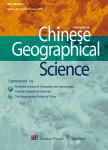Spatio-Temporal Impact of Rural Livelihood Capital on Labor Migra- tion in Panxi, Southwestern Mountainous Region of China
Spatio-Temporal Impact of Rural Livelihood Capital on Labor Migration in Panxi, Southwestern Mountainous Region of China作者机构:Institute of Mountain Hazards and Environment Chinese Academy of Sciences Chengdu 610041 China University of Chinese Academy of Sciences Beijing 100049 China Chengdu University of Information Technology Chengdu 610225 China
出 版 物:《Chinese Geographical Science》 (中国地理科学(英文版))
年 卷 期:2018年第28卷第1期
页 面:153-166页
核心收录:
学科分类:0303[法学-社会学] 120301[管理学-农业经济管理] 12[管理学] 1203[管理学-农林经济管理] 0708[理学-地球物理学] 0705[理学-地理学] 0813[工学-建筑学] 0704[理学-天文学] 0833[工学-城乡规划学]
基 金:Under the auspices of the National Natural Science Foundation of China(No.41471469,41601141) the National Key Basic Research Program of China(No.2015CB452706) the Humanities and Social Sciences Youth Project of Ministry of Education in China(No.14YJCZH130) Youth Talent Team Program of the Institute of Mountain Hazards and Environment,Chinese Academy of Sciences(No.SDSQB-2015-01)
主 题:labor migration livelihood capital spatio-temporal impact southwestern mountainous region China
摘 要:Labor migration to urban centers is a common phenomenon in the Panxi region of the southwestern mountainous region of China, mainly owing to inadequate livelihood capital in rural areas. Numerous studies have been conducted to explore the relationship between labor migration and its causes, such as individual and family characteristics, but few studies have focused on livelihood capital. This paper examines the impact factors on labor migration employment location selection and duration from a household livelihood capital perspective. A case study of 279 households from 10 villages in the area was carried out in February 2016. We used both qualitative and quantitative methods to analyze the data. On the basis of the 279 questionnaires, the proportion of households with non-labor migration is 48.4%, whereas households with labor migration within a local city and migration across regions account for 28.7% and 22.9%, respectively. Social, financial, and human capitals are the primary factors that influence migrants employment location choice positively. Among them, social capital has a significant impact on both migration within a local city and across regions; each of the regression coefficients is 1.111 and 1.183. Social, human, and financial capitals also have a positive impact on the duration of labor migration, and similarly, social capital is the highest coefficient with 2.489. However, physical capital only partly impacts labor migration across regions, whereas the impact of labor migration within a local city, and the duration, are not significant. Furthermore, the impact of household natural capital on migration space and time are all negative relationships, especially for labor migration across the regions and duration, with coefficient scores of 4.836 and 3.450, respectively. That is to say, a laborer is inclined to migrate within a local city for a short term, or not migrate at all, if natural capital is abundant. Our analysis results show that household l



